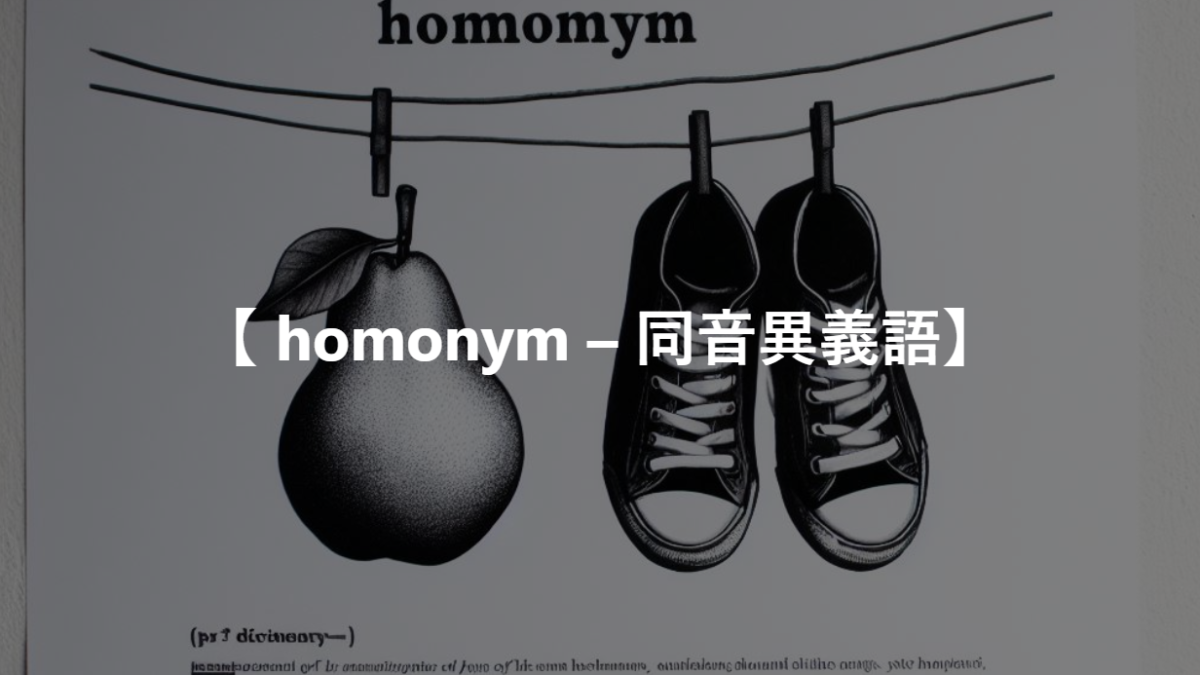派生語・語源・類義語・反対語・例文
【 homonym – 同音異義語】という単語の語源とか由来を知っていますか?
「homonym」は、ギリシャ語の「homos」(同じ)と「onoma」(名前)から派生しています。
「homos」は「同じ」を意味し、「onoma」は「名前」を意味します。したがって、「homonym」は「同じ名前」という意味を持ちます。
この言葉は、同じ発音を持つが意味やつづりが異なる単語を指すために使用されます。同音異義語は、発音が同じでも意味が異なるため、コミュニケーションや文脈理解において誤解を招く可能性があります。
「homonym」は言語学の分野でよく使われる用語であり、同音異義語の存在を説明するために使用されます。
この単語の類義語・反対語を教えてください。
類義語:
- Homophone (同音異字語):発音が同じだが綴りや意味が異なる単語。
- Homograph (同綴異音異義語):綴りは同じだが、発音や意味が異なる単語(一部の定義によると、同音異義語を含むこともあります)。
反対語:
- Antonym (反意語):意味が正反対の単語。
- Heteronym (異綴異音異義語):発音と綴りが異なる単語。
この単語に似た単語で間違いやすい単語はありますか?
- Homophone: 先ほども述べたように、同音異義語の一種を指す単語です。しかし、語義や用法が異なるため、注意が必要です。
- Synonym: 「synonym」は、「同義語」という意味の単語です。発音やつづりが異なる単語ではなく、意味が類似している単語を指します。
- Homograph: 先ほども述べたように、同形異義語の一種を指す単語です。発音は異なるが、同じつづりを持つ単語を指します。
この単語を使った例文を5つほど教えてください。
- The words “pear” and “pair” are homonyms because they sound the same but have different meanings.
(”pear”と”pair”は同音異義語です。同じように聞こえますが、意味が異なります。) - “Bass” can be a homonym, referring to either a low-frequency sound or a type of fish.
(”Bass”は同音異義語であり、低周波の音や魚の一種を指す場合があります。) - The English language has many homonyms, such as “write” and “right,” which can cause confusion for language learners.
(英語には多くの同音異義語があります。例えば、”write”と”right”は混乱を引き起こすことがあります。) - The word “bank” is a homonym, as it can refer to a financial institution or the edge of a river.
(”bank”は同音異義語です。金融機関または川の岸を指すことができます。) - “Knight” and “night” are homonyms that sound identical but have completely different meanings.
(”knight”と”night”は同音異義語であり、完全に異なる意味を持ちます。)
【 homonym – 同音異義語】のコロケーション
- homonym examples – 同音異義語の例 発音が同じで意味が異なる単語の例を指します。
- identify homonyms – 同音異義語を特定する 文脈や会話の中で同音異義語を見つける行為を意味します。
- use of homonyms – 同音異義語の使用 言葉遊びや文学的表現など、様々な文脈で同音異義語を使用することを指します。
- confusion with homonyms – 同音異義語による混乱 同じように発音される単語の意味の違いによって発生する混乱を表します。
- teaching homonyms – 同音異義語の教育 学校や言語教育の文脈で同音異義語を教えることを意味します。
文法問題
問題 1
The word “bat” is a __; it can refer to a flying mammal or a piece of sports equipment.
- a) homonyms
- b) homonym
- c) homonymous
- d) homonymously
解説: 正解は b) homonym です。「同音異義語」を意味する名詞の単数形が適切です。
問題 2
Can you think of another example of a __ in English?
- a) homonyms
- b) homonym
- c) homonymous
- d) homonymously
解説: 正解は b) homonym です。「同音異義語」を意味する名詞の単数形が適切です。
問題 3
“Lead” and “lead” are __ that can be confusing for learners.
- a) homonyms
- b) homonym
- c) homonymous
- d) homonymously
解説: 正解は a) homonyms です。「同音異義語」を意味する名詞の複数形が適切です。
問題 4
The sentence used several __ to illustrate the concept.
- a) homonyms
- b) homonym
- c) homonymous
- d) homonymously
解説: 正解は a) homonyms です。「同音異義語」を意味する名詞の複数形が適切です。
問題 5
Understanding __ is important for mastering English vocabulary.
- a) homonyms
- b) homonym
- c) homonymous
- d) homonymously
解説: 正解は a) homonyms です。「同音異義語」を意味する名詞の複数形が適切です。

